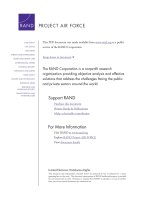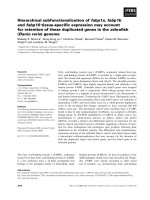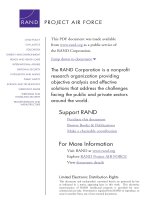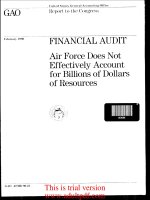FINANCIAL AUDIT Air Force Does Not Effectively Account for Billions of Dollars_part1 ppt
Bạn đang xem bản rút gọn của tài liệu. Xem và tải ngay bản đầy đủ của tài liệu tại đây (878.79 KB, 12 trang )
__
____._._
__._
._
.
^
.1
GAO
____,_ l_“ ,_.,
_ ._ ._ .__._ l__i
_ _ _. -__ ___
I+‘c~l,IYl;l I’\’ 1 !l!)O
._
_ I~ ,ll_ l___-l_l I __- -
__________-
FINANCIAL AUDIT
Air Force Does Not
Effectively Account
for Billions of Dollars
of Resources
This is trial version
www.adultpdf.com
I
I
,
I
I
/
/
United States
General Accounting Office
Washington, D.C. 20648
Comptroller General
of the United States
B-234326
February 23,199O
To the President of the Senate and the
Speaker of the House of Representatives
This report presents the results of our review of the Air Force’s financial management
operations and its efforts to prepare consolidated financial statements. While the financial
statements, included as appendix I, purport to show the Air Force’s financial position and
results of operations for fiscal year 1988, our audit work demonstrates that the Air Force
does not have accurate cost data for almost all of its non-cash assets.
Air Force managers are accountable for $276 billion in weapons systems, inventories, and
other assets and for annual appropriations of over $90 billion. However, the Air Force’s
financial management systems and internal controls are not sufficient to provide adequate
and reliable financial information for effective management of the Air Force’s diverse and
complex operations. Our report discusses these problems and contains recommendations for
corrective actions.
We are sending copies of this report to the Secretaries of the Air Force and Defense, the
Director of the Office of Management and Budget, interested congressional committees, and
other interested parties.
This report was prepared under the direction of David M. Connor, Director, Defense
Financial Audits, who may be reached on (202) 27.59406 if you or your staff have any
questions.
Charles A. Bowsher
Comptroller General
of the United States
This is trial version
www.adultpdf.com
Qecutive Summq
Puipose
Through the 1980s there have been mounting concerns over the federal
government’s declining fiscal condition and the ineffective management
and control over its financial operations. While various reforms are
being considered and others are under way, more urgent and decisive
actions are needed to deal effectively with these concerns and problems.
Over the last several years,
GAO
has conducted a number of financial
audits of major federal civilian agencies and departments which show
that government managers do not adequately (1) control their costs and
resources, (2) provide the Congress and the public a true accounting for
the assets entrusted to them, and (3) consider financial information in
making decisions.
There is no better way to gain an understanding of the problems and
required corrective actions associated with the financial management
operation of an agency than to do a full scale audit of its financial state-
ments. To begin to gain a perspective on the quality of the information
and systems available in the Department of Defense
(DOD),
the largest
department of government,
GAO
attempted to conduct a financial audit
of the Air Force. The Air Force is the only military service which has
tried to prepare a set of financial statements in accordance with gener-
ally accepted accounting principles for federal agencies.
Background
The Air Force is responsible for weapons systems, inventories, and other
assets reportedly valued at $275 billion and, as of September 30, 1988,
had thousands of outstanding contracts valued at over $250 billion. The
Air Force annually receives appropriations of about $90 billion. It oper-
ates over 130 bases located throughout the world, representing about 16
percent of the real property held by the government and employs about
900,000 civilian and military personnel.
The Air Force dwarfs the largest organizations in the private sector as
well as most other federal agencies. Being a government agency, the Air
Force is not a profit making organization, but as one of the world’s larg-
est organizations, it needs to be concerned about, and should be held
accountable for controlling its costs, operating efficiently, and protect-
ing its resources. Accountability for its extensive operations can only
flow from integrated systems that accurately capture, process, and
report day-to-day financial transactions and provide firm control over
costs and resources.
Page 2
GAO/AFMD-90-23 Air Force Financial Audit
This is trial version
www.adultpdf.com
ExecutiveSummary
The integrity of these data and the systems that process them, as well as
the reports used within and outside the organization, are best ensured
by regular, periodic independent financial audits, Such audits provide
the discipline needed to ensure that bad data, systems, and reports are
highlighted for improvement.
To its credit, the Air Force attempted to produce a set of financial state-
ments for 1988 and submitted them to
GAO
for audit.
Rehlts in Brief
The Air Force does not have accurate cost data for almost all of its non-
cash assets such as inventory, equipment, aircraft and missiles.
Accounts for over 70 percent of the assets on its consolidated statement
of financial position were unauditable, and
GAO
was, therefore, unable to
express an opinion on the financial statements for fiscal year 1988.
Also, because of these weaknesses, the financial information produced
by the Air Force and reported to the Office of Management and Budget
and the Department of the Treasury is not reliable. In contrast, the fund
control procedures, that is, making sure spending limits are not
exceeded, generally operate effectively.
There are many reasons why the accounts were unauditable. The Air
Force does not have financial systems that produce reliable financial
data. A number of large dollar items-aircraft and accounts payable,
for example-are not included in its accounting systems. A double-entry
set of books with a general ledger system is not maintained to establish
full accountability over costs and assets. To balance its accounts, the Air
Force made a large number of adjustments-some over $1 billion-but
the bases for these adjustments could not be explained by Air Force offi-
cials The inventory systems do not provide reliable data to support
either the quantities or the values of inventories on hand. There is not
an accounting for the full cost of its weapons systems-the cost of the
B-l bomber system alone is understated by at least $7.1 billion in the
financial statements.
The Air Force needs better historical cost data to improve its budgeting
and planning processes and it needs better financial systems to establish
accountability over the billions of dollars of assets entrusted to it.
The Air Force is not unmindful of some of its problems and has taken a
number of actions to correct these problems on a case-by-case basis.
That it took the initiative to prepare financial statements and have them
audited is an important step. The Air Force also has long-term projects
Page 3
GAO/AFMD-90-23 Air Force Financial Audit
This is trial version
www.adultpdf.com
Executive Summary
under way that are intended to address several of its financial manage-
ment weaknesses. But more needs to be done. It is evident that cost
effectiveness and efficiency need to become an Air Force priority and an
important part of the organization’s culture if meaningful and lasting
improvements in its financial management are to be achieved.
Pr&pal Findings
Financial Systems Do Not
The Air Force accounting and financial management systems can neither
Prdvide Reliable Financial
provide complete and reliable financial data nor be depended upon to
Data
report accurately on the resources entrusted to its managers. Much
information that is produced is not timely. Financial reports cannot be
/
developed without extensive, manual, time-consuming efforts to compile
data from a variety of sources. These conditions adversely affect finan-
cial reporting and management at all levels, ranging from the Air Force
consolidated financial statements down to base-level financial reports.
The General Accounting and Finance System was to serve as the Air
Force’s general ledger, but a number of very significant accounts were
not included. Certain data, such as aircraft values ($82 billion) and
accounts payable amounts ($18 billion) had to be derived from property
systems or from extracts of budgetary data rather than from a properly
designed financial management system.
Financial reports to the Office of Management and Budget and the Trea-
sury are also inaccurate and unreliable. In recent years, some Air Force
components failed to submit financial data in time to be included in the
year-end Treasury reports. As a result, March 31 data was used in lieu
of missing September 30 data. Furthermore, over $25 billion of Air
Force assets were not included in financial reports to the Treasury, and
an additional $10 billion in transactions were counted twice.
Financial information requires constant analysis to ensure its validity.
GAO'S
analysis of selected accounts revealed obvious problems, such as
negative values for certain inventories. As a minimum, these warranted
further investigation so that appropriate actions could be taken and cor-
rections made. In many instances, Air Force officials simply have
allowed obvious erroneous data to remain in the accounting records, and
these data are ultimately included in agency financial statements and
other financial reports.
Page 4
GAO/AFMD-90-23 Air Force Financial Audit
This is trial version
www.adultpdf.com
Emcutlve Summary
As early as November 1983, the Air Force recognized weaknesses in the
current systems and reported its general ledger accounting system as
deficient to the Secretary of Defense. The Air Force subsequently con-
tracted for the development of requirements for a new general ledger
accounting system and currently is in the early stages of soliciting con-
tracts to develop and implement it. However, this system does not
directly cover the major portion of Air Force assets, and the Air Force
does not expect it to be operational before 1994.
With the current and foreseeable budget constraints and changing mili-
tary threat, 1994 is not soon enough to show major improvements. The
Air Force will need to make major decisions in the near term and will
need accurate data to make them. What the Air Force needs to do now is
to take interim steps to improve the quality of data it derives from
existing systems as well as undertake steps to upgrade and replace those
systems. The choice between upgrading, replacing, or both should be
based, in part, on the time it takes to achieve substantial improvement
in the available financial management data.
Air Force Has Ba
Internal Control
Weaknesses
sic
The Air Force has significant internal control weaknesses, some of
which it disclosed in its 1988 Federal Managers’ Financial Integrity Act
report, and others which
GAO
noted in its audit work. The Air Force
reported that two of its accounting systems, including the General
Accounting and Finance System, did not conform to prescribed princi-
ples and standards.
GAO
identified other material control weaknesses. Unsupported and arbi-
trary adjustments totalling billions of dollars were made to account bal-
ances and records throughout fiscal year 1988. The Space Systems
Division trial balance for March 31, 1988, differed from its subsidiary
records by $2.4 billion. In order to get agreement, records were adjusted
without support. By not performing reconciliations and by making
unsupported adjustments, accountability was lost and the opportunity
to determine and address the causes of possible instances of mismanage-
ment, fraud, or abuse was missed.
Full Costs of Weapons
Systems Not Identified
The Air Force financial systems do not provide its managers with com-
plete and reliable information on either the acquisition or operating
costs of its aircraft and missile systems. For example, the procurement
cost for each B-l bomber is reported by the Air Force to be $150 million;
GAO
found that the cost is, in fact, about $219 million. The total reported
Page 6
GAO/AFMD-90-23Air ForceFinancialAudit
This is trial version
www.adultpdf.com
Executive Summary
cost of the B-l system-
$21 .Q billion-is understated by at least $7.1
billion. Similar understatements exist for the F-16 aircraft ($6.8 billion)
and the F-16 aircraft ($6.3 billion). The gaps are even wider if all the
government-furnished materials provided to contractors for aircraft
production and related research and development are considered.
Air Force property systems do not track military hardware in the hands
of contractors. For example, $630 million of satellites and $5.7 million of
engines for C-20A cargo planes were paid for by the Air Force and held
by contractors but not recorded in any Air Force property or accounting
system.
Selected Acquisition Reports sent to the Congress include more accurate
actual costs on weapons systems, but these costs were also not complete.
As a result, actual cost information is not available in the accounting
systems for reporting to top Air Force and
DOD
officials, the Congress,
and the public, nor are such data available to Air Force managers for
decisionmaking at any level.
Inventory Systems Do Not
The Air Force maintains a reported $63.8 billion in inventories of sup-
Provide Accurate Data
plies and spare parts, eight times the inventories reported by General
Motors, one of the largest corporations in the United States. However,
the systems used to provide accountability over these immense invento-
ries do not provide reliable data supporting either their quantities or
value.
GAO'S
current audit work, other recent
GAO
reports, and work by the Air
Force all confirm that long-standing Air Force problems in controlling its
inventories have not been resolved. Records of quantities on hand at Air
Logistics Centers, which reflect about $40 billion in inventory items, are
often inaccurate. Recordkeeping deficiencies contribute to $10 billion of
unrequired inventory. In addition, over 50 percent of the dollar value of
investment-item inventory at the Air Logistics Centers needs
repair,
overhaul, or extensive maintenance to become serviceable, yet such items
are valued the same as usable items.
Page 6 GAO/AFMD-90-23 Air Force Financial Audit
This is trial version
www.adultpdf.com
Executive Summary
Los4 of Accountability and
When accountability and accurate cost information are not maintained,
Inadcurate Cost
the following conditions result:
Infojrmation
l
Financial information needed for top management’s or the Congress’
analysis of Air Force trends is unreliable.
. Operating costs of air wings, bases, depots, and commands cannot be
compared and evaluated.
l
Losses can occur from fraud, waste, abuse, and mismanagement yet not
be identified and their causes dealt with.
. Inventories cannot be managed effectively to avoid shortages or exces-
sive stocks.
. Cost cannot be properly considered when deciding to replace or upgrade
existing weapons systems.
. The basis for evaluating procurements and budget requests is not as
complete as it might be.
There is no question that better cost data would improve the manage-
ment control, budgeting, and planning processes of the Air Force. Only
in cases where funds are unlimited and efficiency can be ignored can
costs be considered unimportant, Neither case is true today-if it ever
was true.
Recommendations
improve financial management and bring greater efficiency to Air Force
operations, The recommendations focus on utilizing existing financial
information and developing more accurate financial information (chap-
ter 2), performing reconciliations and documenting adjustments (chapter
3), accounting for costs of weapons systems (chapter 4), achieving
financial management of inventories (chapter 6), and developing a new
accounting system (chapter 6).
Agency Comments
DOD
concurred or partially concurred with all of
GAO'S
recommendations.
(See appendix IV.) In commenting on many of the recommendations,
DOD
cited initiatives, discussed in the July 1989 Defense Management Report
sent to the President, as being responsive to
GAO'S
recommendations.
However, the Defense Management Report describes the efforts to
achieve the initiatives’ objectives in broad, general terms. It does not
contain detailed plans or milestones of the specific actions that would be
required to successfully implement the initiatives.
DOD
stated that it was
Page 7
GAO/AFMLl-90-23 Air Force Financial Audit
This is trial version
www.adultpdf.com
Executive Summary
unable to provide a comprehensive response with milestones for correc-
tive actions in time for inclusion in
GAO'S
report, It said that a compre-
hensive response will be provided on the final report.
Overall,
DOD
said that it has been providing accurate and reliable data to
the Congress on weapons systems, but it is aware that the Air Force
accounting systems, including financial controls over inventories and
government-furnished materials, need improvement.
DOD
also said that it
will endeavor to make accounting and reporting data more consistent in
future reports.
Page 8
GAO/AFMD-90-23 Air Force Financial Audit
This is trial version
www.adultpdf.com
C&dents
Ex$cutive Summary
The Government’s Financial Information and Control
Environment
Meaningful Financial Statements and Audits Can
Strengthen Federal Financial Management
Department of the Air Force
Objectives, Scope, and Methodology
16
18
18
Chhpter 2
Fidancial Management
Need for Meaningful, Accurate Financial Statements
Sy$tems Do Not
Unreliable Reporting to Treasury
Financial Management Systems Are Not Used Effectively
Prdvide Reliable
to Manage Resources
Financial Information ~~~~~~~~~ations
21
22
26
28
33
34
Chapter 3
Agency Comments and Our Evaluation
Internal Control
Wtiaknesses Prevent
Accurate Financial
Accounts Not Routinely Reconciled
Account Balances Contain Unsupported, Arbitrary
Adjustments
Other Internal Control Weaknesses
36
36
36
39
Reporting and Reduce ~~~~~~~~ations
Accountability Over
Agency Comments
Assets
Chapter 4
Actual Costs of
1
Actual Cost of Aircraft and Missiles in Production Is
Aircraft and Missiles
Are Not Known
Unknown
Value of Aircraft and Missiles Is Not Based on Cost
Government-Furnished Materials Not Included in
Valuations
Aircraft and Missile Modifications Are Not Capitalized
Operating Costs of Aircraft and Missiles Are Not Known
Controls Over Contractor-Held Property Are Not in Place
Improvements Needed in Weapons Systems Cost
Management
41
46
46
47
48
49
60
53
53
54
66
66
Page 9
GAO/AFMD-90-23 Air Force FinanciaJ Audit
This is trial version
www.adultpdf.com
Contents
Conclusions
59
Recommendations 60
Agency Comments
60
Ch’
i
pter 5
61
In entory Systems Do
Scope of Inventory Management Operations
61
No provide Accurate
Inaccurate Records of Inventory Quantities
63
Unreliable Inventory Values 66
Financial Data
Change in Cost Accounting System Is Needed
67
Other Inventory Weaknesses
68
Conclusions 70
Recommendations
71
Agency Comments and Our Evaluation 71
Chapter 6
Air Force Financial
Systems Alternatives for Developing Meaningful
Management System
Financial Information
Improvement Efforts
Plans to Develop a New Base-Level Accounting System
BLARS Status and Objectives
BLARS Requirements
Other Comments on the BLARS Development Effort
Conclusions
Recommendations
Agency Comments
72
73
74
75
75
76
78
78
79
Appendixes
Appendix I: Consolidated Financial Statements of the U.S.
Air Force for the Fiscal Year Ending September 30,
1988
Appendix II: Comparisons Between Air Force Financial
Statements and Treasury Reports
97
Appendix III: Objectives, Scope, and Methodology
99
Appendix IV: Comments From the Department of Defense
101
Tables
Table 2.1: Accounts Developed From Alternative Sources
Table 2.2: Examples of AFSC Control Account Balances
With Significant Changes
24
30
Table 2.3: Variances in Divisional Trial Balances From
Period to Period
31
Table 2.4: Variances Among Divisional Trial Balances at
September 30,1988
31
Page 10
GAO/AFMD-90-23 Air Force Fhncial Audit
This is trial version
www.adultpdf.com
Contents
Table 2.6: Air Bases With Credit Balances for Medical/
Dental Stock Fund Inventories
32
Table 2.6: Air Bases With Credit Balances in
Construction-In-Process Accounts
Table 4.1: Procurement Expenditures on Selected Aircraft
Programs Calculated by AVISURS and GAO
Table 4.2: Expenditures on Selected Aircraft Programs
Reported in SARs and Calculated by GAO
Table 6.1: Inventory Distribution as of September 30,
1988
33
52
52
63
Table 6.2: Unserviceable Inventory Not Reported as Such
in Air Force Records
65
Page 1 I
GAO/AFMD40-23 Air Force Financial Audit
This is trial version
www.adultpdf.com









